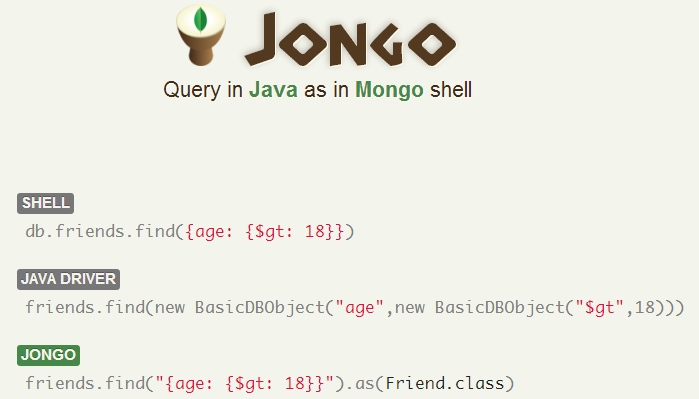版权声明:本文为博主原创文章,未经博主允许不得转载。 https://blog.csdn.net/whxaing2011/article/details/37997239
1、Jongo可以用来做什么?
Jongo框架的目的是使在MongoDB中可以直接使用的查询Shell可以直接在Java中使用。在官网首页有一个非常简洁的例子:

SHELL:这种查询方式是MongoDB数据库支持的查询方式。
JAVA DRIVER:是MongoDB Java驱动API中提供的查询方式
JONGO:就是jongo框架提供的查询方式。
由此可以看出,JONGO框架的意图很明显。
2、Jongo的下载
关于MongoDB的安装在此不作赘述,大家可以去它的官网上查看,介绍的非常详细了,
http://docs.mongodb.org/manual/installation/。
在Jongo的官网上,介绍说jongo框架的使用依赖于 Jackson 2.2.3, Bson4Jackson 2.2.3 and Mongo Java Driver 2.11+,而jongo目前最新的版本为1.0。通过我的尝试,我发现在实际应用中需要用到以下jar包:
bson4jackson-2.3.1.jarjackson-annotations-2.4.1.jarjackson-core-2.4.1.1.jarjackson-databind-2.4.1.2.jarjongo-1.0.jarmongo-java-driver-2.12.2.jar
这些jar包都可以在Maven仓库中找到,
http://mvnrepository.com/
Jongo官网:
http://jongo.org/
Jongo GitHub:
https://github.com/bguerout/jongo
3、Jongo的使用
PersonInfo类:
package com.jongo.enties;
public class PersonInfo {
private int id;
private String person_name;
private String sex;
private String relationship;
public PersonInfo() {
}
//getter and setter
@Override
public String toString() {
return "PersonInfo [id=" + id + ", person_name=" + person_name
+ ", sex=" + sex + ", relationship=" + relationship + "]";
}
}
1)第一个简单的例子
package com.jongo.demo;
import java.util.Iterator;
import org.jongo.Jongo;
import org.jongo.MongoCollection;
import com.jongo.enties.PersonInfo;
import com.mongodb.DB;
import com.mongodb.MongoClient;
public class FirstDemo {
public static void main(String[] args) {
MongoClient mongo = null;
try {
mongo = new MongoClient("localhost",27017);
DB db = mongo.getDB("jongo");
Jongo jongo = new Jongo(db);
MongoCollection person_info = jongo.getCollection("person_info");
@SuppressWarnings("unchecked")
Iterator<PersonInfo> all = (Iterator<PersonInfo>) person_info.find().as(PersonInfo.class);
while(all.hasNext()) {
PersonInfo personInfo = all.next();
System.out.println("all:"+personInfo);
}
PersonInfo one = (PersonInfo) person_info.findOne("{id:1}").as(PersonInfo.class);
System.out.println("one:"+one);
} catch(Exception e) {
e.printStackTrace();
} finally {
if(mongo != null) {
mongo.close();
}
}
}
}
运行结果:
all:PersonInfo [id=1, person_name=xiaoming, sex=Man, relationship=Friend]
all:PersonInfo [id=2, person_name=xiaohong, sex=Male, relationship=Friend]
one:PersonInfo [id=1, person_name=xiaoming, sex=Man, relationship=Friend]
2)Jongo的Save
PersonInfo personInfo = new PersonInfo(4,"Marry","Male","ClassMate");
mcoll.save(personInfo);
3)Jongo的Update
在Jongo中,Update语法和Mongo Shell有一点点不同,修改的查询语句需要通过使用with()来实现,with()内可以包含一个字符串,或者是一个对象。
(1)person_info.update(new ObjectId("53cb7d99b963ac657273328c")).with("{$inc: {id: 2}}");
原始记录:{ "_id" : ObjectId("53cb7d99b963ac657273328c"), "id" : 6, "person_name" : "Dark", "sex" : "Male", "relationship" : "ClassMate" }
更新后:{ "_id" : ObjectId("53cb7d99b963ac657273328c"), "id" : 8, "person_name" : "Dark", "sex" : "Male", "relationship" : "ClassMate" }
(2)person_info.update("{person_name : 'Dark'}").with("{$set:{person_name:'Dark Update'}}");
原始记录:{ "_id" : ObjectId("53cb7d91b963ac657273328a"), "id" : 5, "person_name" : "Dark", "sex" : "Male", "relationship" : "ClassMate" }
更新后:{ "_id" : ObjectId("53cb7d91b963ac657273328a"), "id" : 5, "person_name" : "Dark Update", "sex" : "Male", "relationship" : "ClassMate" }
这种Update方式只会改变第一个被找到的记录。而下面这种方式将会更新所有person_name为Dark的记录:
person_info.update("{person_name : 'Dark'}").multi().with("{$set:{person_name:'Dark Update'}}");
(3)person_info.update("{person_name : 'Dark'}").with(new PersonInfo(10, "Dark Update Object", "Man", "ClassMate"));
原始记录:{ "_id" : ObjectId("53cb82ebb963ac657273329d"), "id" : 5, "person_name" : "Dark", "sex" : "Male", "relationship" : "ClassMate" }
更新后:{ "_id" : ObjectId("53cb82ebb963ac657273329d"), "id" : 10, "person_name" : "Dark Update Object", "sex" : "Man", "relationship" : "ClassMate" }
(4)person_info.update("{person_name : 'Dark'}").with("{$set:{address:#}}",new Address("0755","shenzhen"));
原始记录:{ "_id" : ObjectId("53cb8310b963ac657273329e"), "id" : 5, "person_name" : "Dark", "sex" : "Male", "relationship" : "ClassMate" }
更新后:{ "_id" : ObjectId("53cb8310b963ac657273329e"), "id" : 5, "person_name" : "Dark", "sex" : "Male", "relationship" : "ClassMate", "address" : { "regionI
d" : "0755", "provinceName
" : "shenzhen" } }
4)Jongo的Insert
(1)person_info.insert("{person_name:'Insert Demo'}");
结果:{ "_id" : ObjectId("53cb85cf2fd87f4058d1ff93"), "person_name" : "Insert Demo" }
(2)插入一条记录
PersonInfo personInfo = new PersonInfo(6,"Marry Insert","Male","ClassMate");
person_info.insert(personInfo);
结果:{ "_id" : ObjectId("53cb85e0b963ac65727332a3"), "id" : 6, "person_name" : "Marry Insert", "sex" : "Male", "relationship" : "ClassMate" }
(3)插入多条记录:
PersonInfo personInfo2 = new PersonInfo(7,"Marry Insert2","Male","ClassMate");
person_info.insert(personInfo,personInfo2); //方式一
person_info.insert(new Object[]{personInfo,personInfo2});//方式二
5)Jongo的Remove
person_info.remove(); //删除所有
person_info.remove(new ObjectId("53cb87c02fd8f9ffd258ceb3"));
person_info.remove("{person_name:'Marry Insert'}");
6)Jongo的Query
在Jongo中,Query和Mongo Shell中的Query几乎是一致的。
我们先来看看在Mongo Shell中如何查询:
原始记录:
{ "_id" : ObjectId("53cb8e8a2602b31118434306"), "id" : 2, "person_name" : "xiaohong", "sex" : "Male", "relationship" : "Friend" }
//对于数字类型
> db.person_info.find({id:2});
或者
> db.person_info.find({"id":2});
{ "_id" : ObjectId("53cb8e8a2602b31118434306"), "id" : 2, "person_name" : "xiaohong", "sex" : "Male", "relationship" : "Friend" }
//对于字符串类型
> db.person_info.find({person_name:'xiaohong'});
或者
> db.person_info.find({"person_name":"xiaohong"});
{ "_id" : ObjectId("53cb8e8a2602b31118434306"), "id" : 2, "person_name" : "xiaohong", "sex" : "Male", "relationship" : "Friend" }
那么,在Jongo中怎么查询呢?其实,在上面的第一个简单例子中我们已经见识过了,
Iterator<PersonInfo> all = (Iterator<PersonInfo>) person_info.find().as(PersonInfo.class);
PersonInfo one = (PersonInfo) person_info.findOne("{id:1}").as(PersonInfo.class);
我们再来看看这种文档结构:{ "_id" : ObjectId("53cb9015b963ac65727332a4"), "id" : 5, "person_name" : "Dark", "sex" : "Male", "relationship" : "ClassMate", "address" : { "regionI
d" : "0755", "provinceName" : "shenzhen" } },假如我要查询出address中regionId为0755的记录,该怎么做?
在Mongo Shell中,我们是这样查询的:db.person_info.find({"address.regionId":"0755"});或者db.person_info.find({'address.regionId':'0755'});
在Jongo中的做法也是如出一辙,
PersonInfo personInfo =
(PersonInfo) person_info.findOne("{address.regionId:'0755'}").as(PersonInfo.class);
7)Jongo如何查询出指定字段(不查询某字段)?
我们一般通过{field:1}或{field:0}来控制查询字段的显示与否。
在Mongo Shell中,做法如下:
> db.person_info.find({},{person_name:1,_id:0}); //查询出
person_name,不查询出_id。
{ "person_name" : "xiaohong" }
{ "person_name" : "Dark" }
而在Jongo中我们需要使用
projection来到达这种效果。
PersonInfo personInfo =
(PersonInfo) person_info.findOne().projection("{person_name:1,id:1}").as(PersonInfo.class);
8)Jongo的Sort、Skip、Limit、Hint、Count
在Jongo中
Sort、Skip、Limit、Hint、
Count
基本和Mongo Shell一致。
假设数据集合中有这样两天记录:
> db.person_info.find()
{ "_id" : ObjectId("53cb8e8a2602b31118434306"), "id" : 2, "person_name" : "xiaohong", "sex" : "Male", "relationship" : "Friend" }
{ "_id" : ObjectId("53cb9015b963ac65727332a4"), "id" : 5, "person_name" : "Dark", "sex" : "Male", "relationship" : "ClassMate", "address" : { "regionI
d" : "0755", "provinceName" : "shenzhen" } }
Iterator<PersonInfo> sort = (Iterator<PersonInfo>) person_info.find().sort("{id:1}").as(PersonInfo.class);//sort {field:1} 升序,{field:-1} 降序
Iterator<PersonInfo> skip = (Iterator<PersonInfo>) person_info.find().skip(1).as(PersonInfo.class);//查询时跳过多少条记录
Iterator<PersonInfo> limit = (Iterator<PersonInfo>) person_info.find().limit(2).as(PersonInfo.class);//查询指定数量的记录
Iterator<PersonInfo> hint = (Iterator<PersonInfo>) person_info.find().hint("{person_name:-1}").as(PersonInfo.class);//在查询过程中强制使用hint指定的索引方式,注意必须事先建立person_name字段的倒序索引。
long len = person_info.count("{id:5}");//查询满足条件的记录数
9)Jongo的Oid
在映射部分,_id的定义可有注解@ObjectId来控制,如果你想完全地避免使用原先驱动包的ObjectId,可以使用Jongo提供的Oid类。其用法如下:
import static org.jongo.Oid.withOid;PersonInfo personInfo= new PersonInfo(); // @ObjectId String _id PersonInfo类中需要定义一个名为_id的字段,且加上@ObjectId注解
person_info.save(personInfo);
person_info.find(withOid(personInfo._id)).as(PersonInfo .class); // instead of new ObjectId(personInfo._id)
10)Jongo的查询模板
几乎所有查询Jongo可以模板化:添加锚#。绑定参数可以BSON原语或任何复杂类型。
PersonInfo personInfo = person_info.findOne("{id:#,person_name:#}",2,"xiaohong").as(PersonInfo.class); //相当于findOne("{id:2,person_name:'xiaohong'}")
PersonInfo personInfo2 = person_info.findOne("{address:#}",new Address("0755","shenzhen")).as(PersonInfo.class); //相当于 db.person_info.findOne({'address.regionId':'0755','address.privinceName':'shenzhen'});
Iterator<PersonInfo> ite = (Iterator<PersonInfo>) person_info.find("{id:{$in:#}}",ids).as(PersonInfo.class); //相当于db.person_info.find({id:{$in:[2,5]}});
11)Jongo的正则查询
以下几种正则查询都是等价的:
PersonInfo personInfo1 =
person_info.findOne("{person_name:{$regex:#}}","Dar.*").as(PersonInfo.class);
PersonInfo personInfo2 =
person_info.findOne("{person_name:{$regex:'Dar.*'}}").as(PersonInfo.class);
PersonInfo personInfo3 =
person_info.findOne("{person_name:#}",Pattern.compile("Dar.*")).as(PersonInfo.class);
Pattern p = Pattern.compile("Dar.*");
PersonInfo personInfo4 =
person_info.findOne("{person_name:{$regex:'"+p+"'}}").as(PersonInfo.class);
12)Jongo的聚合操作
(1)Distinct
List<String> personNames = person_info.distinct("person_name").as(String.class);
List<Address> addresses = person_info.distinct("address").query("{id:5}").as(Address.class);
int size = person_info.distinct("address").query("{id:5}").as(Address.class).size();
(2)聚合框架
这个特性只能在Mongo2.2以上版本中使用,所有诸如$project, $match, $limit, $skip, $unwind, $group, $sort的聚合操作都支持。在官网有一个例子:
collection.aggregate("{$project:{sender:1}}") .and("{$match:{tags:'read'}}") .and("{$limit:10}") .as(Email.class);
4、对象映射
查询结果自动映射到对象,它依赖于Jackson,涉及文档结构,处理列表以及忽略缺失的属性。仅仅需要一个无参构造器(甚至私有构造器都行,前提是对象是不可变的,注解@JsonCreator可以用来替代)
_id在每个MongoDB文档中是一个唯一的标识符,如果没有被设定,它将自动生成,用Jongo来定义它时,一个属性需要被命名为_id或者带有@Id注解(别名 @JsonProperty("_id")),可以使用专门的ObjectId类或者一个简单的由@ObjectId注解的简单字符串来定义。
需要注意的是,当你保存一个自定义的文档_id时(任何Java类型,除了数组意外,只要它是唯一值)总是需要在持久化之前手动的去进行设置。
以下几种情形式需要手动设置_id的:

而下面这几种是自动生成的:
